#Nectariniidae
Explore tagged Tumblr posts
Text
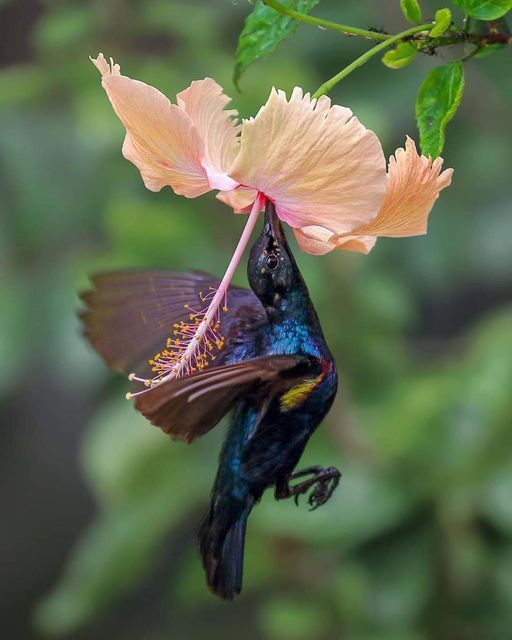
Purple Sunbird (Cinnyris asiaticus) male feeding on nectar, family Nectariniidae, order Passeriformes, India
photograph by Arindam Saha
3K notes
·
View notes
Text
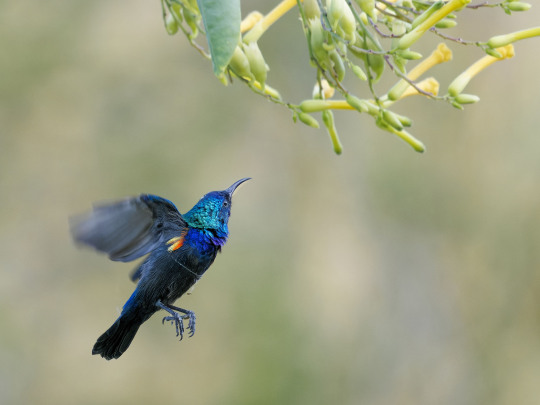
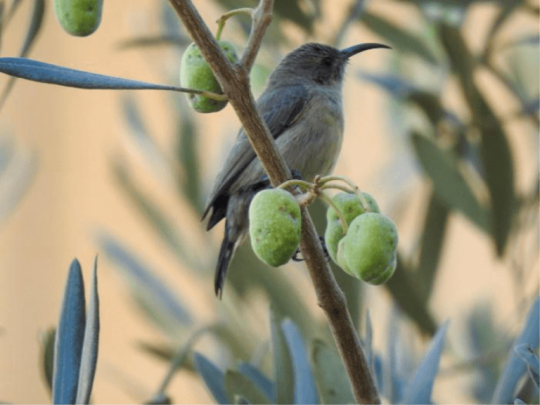
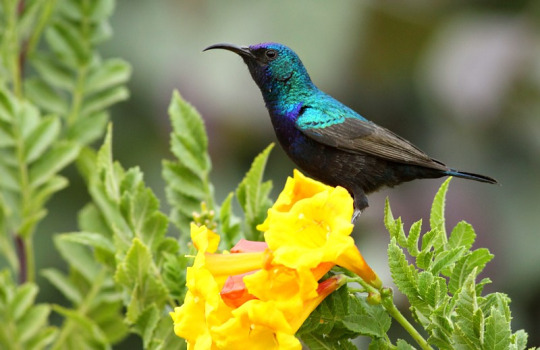
The Palestine Sunbird Persists
The Palestine sunbird, also known as the orange-tufted sunbird (Cinnyris osea) is the national bird of Palestine, and often seen as a symbol of resistance and hope. This species occurs in dry climates, particularly desert, scrubland, and savannahs, but can also be found in orchards and gardens where flowers are abundant. In addition to the Levant, C. osea occurs throughout the southwest cost of Saudia Arabia and the coasts of Yemen and Oman in the south.
C. osea is a small bird, 8 to 12 cm (3.1-4.7 in) long with a wingspan of only 14 to 16 cm (5.5-6.2 in). Males weigh on average 7.6 g (0.26 oz) and females are slightly smaller, at about 6.8 g (0.24 oz). Males are quite easy to identify due to their striking plumage; their feathers are iridescent, appearing dark until they shimmer glossy blue or green, with orange tufts at the side of the breast. In contrast females are fairly drab; grey-brown with a lighter underside. The beaks of the Palestine sunbird are also noted for their distinctively long and curved, which they have developed to efficiently feed on nectar.
Although not directly part of the hummingbird family, the Palestine sunbird shares many similarities with the group. Its diet consists of nectar, and is supplemented with insects. Their tongues are long, and brush-like, and the shape of their beak allows them to reach down to the base of the flower. For flowers that are , they will use their sharp beaks to pierce the side and access the nectar directly. All this is done at very high speeds, but unlike hummingbirds the Palestine sunbird cannot hover in place, and must land in order to feed. Because of their primary reliance on nectar, the orange-tufted sunbird is an important pollinator in its native region. Adults are rarely predated upon, but eggs and young are often targets for lizards, snakes, and birds of prey.
Reproduction begins in June, and continues through October. Males establish and defend territories, and court females by singing to attract a potential mate, then chasing her until she perches to signal her acceptance. Following the pairing, the two construct a purse-like nest, sometimes with a porch-like structure, that hangs from a branch. In this nest, 1-2 eggs are laid, and are incubated primarily by the female, while the male provides her food. The eggs take 13 to 14 days to hatch, and chicks are taken care of by both parents for an additional 14 to 21 days. Individuals can live up to 5 years in the wild.
Conservation status: The Palestine sunbird has a large range and population, and is thus considered Least Concern by the IUCN. Its primary threat is habitat loss due to agriculture and urban development.
If you send me proof that you’ve made a donation to UNRWA or another organization benefiting Palestinians, I’ll make art of any animal of your choosing.
Remember, the donation can be in any amount– every dollar counts!
Photos
Jorrit Vlot
Dula Alhashimi
Rana Hijawi
#Palestine sunbird#Passeriformes#Nectariniidae#sunbirds#perching birds#birds#deserts#desert birds#scrubland#scrubland birds#savannah#savannah birds#urban fauna#urban birds#middle east#animal facts#biology#zoology#ecology#free palestine
1K notes
·
View notes
Text

A Palestine sunbird (Cinnyris osea) perches on a hibiscus
by Artemy Voikhansky
I have had several Palestinian bloggers reach out to this blog for help with their GoFundMe campaigns in dire need of donations. If you can spare even a few dollars for just one of these campaigns, it could change somebody's whole life. If you can't, please reblog this post and share to people who potentially can.
@ranin3344 - Help Rebuild Our Lives in Gaza After Devastating War €8,618 raised of €80,000 vetted by 90s-ghost
@majedgaza1 - Rebuilding Hope: A Gaza Family in Need of Your Help $4,886 raised of $70,000 appears to be vetted
@ronzaanqar - Helping Ahmed's Family: Escaping War to a New Life €59,330 raised of €75,000 vetted and on the spreadsheet
Mohammed M Siam - Help Mohammed Rebuild His Home And Complete His Education $15 raised of $25,000 vetted by association & extremely low on funds!!
@yosef-hussin - Evacuate Kareem & Carmen NOW from Gaza $12,037 raised of $50,000 vetted by 90s-ghost
@yasermohammad - Help my Uncel’s family , BE THE CHANGE €21,989 raised of €35,000 vetted by 90s-ghost
@anasbatran - help me save my family from the war on Gaza, $5,685 raised of $35,000, in the process of being vetted and seems legitimate
@samaagaza - Help me and my family in Gaza $1,075 AUD raised of $20,000, vetted as far as i can tell
@d-mohammed - Safe my Family €4,557 raised of €100,000 donation protected + campaign was verified at one point but the post for that can no longer be found
@familyetaf1234567 - Please help us get out of life's crises and the woes of war. €1,898 raised of €50,000 not yet vetted but ris is clean + donation protected
@asma-family - Help Asmaa Abed Find Safety $837 raised of $20,000 , not yet verified but donation protected
@severekidpersona - Help osama and his family in Gaza €60 raised of €37,000 not yet vetted/verified
#palestine sunbird#sunbirds#birds#cinnyris osea#cinnyris#Nectariniidae#passeriformes#aves#chordata#wildlife: palestine#palestine#gaza
220 notes
·
View notes
Text

[2683/11080] Copper-throated sunbird - Leptocoma calcostetha
Order: Passeriformes Suborder: Passeri Superfamily: Passeroidea Family: Nectariniidae (sunbirds and spiderhunters)
Photo credit: Forest Botial-Jarvis via Macaulay Library
#birds#Copper-throated sunbird#Passeriformes#Passeri#Passeroidea#Nectariniidae#Leptocoma#birds a to z#described
253 notes
·
View notes
Text
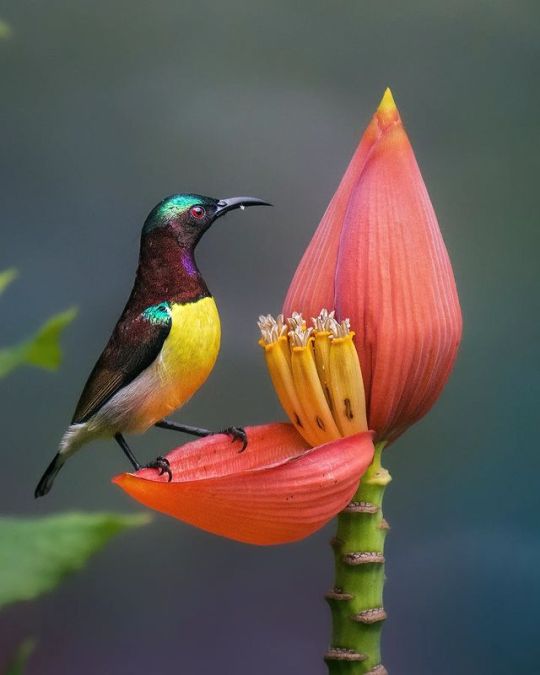
Purple-rumped Sunbird
250 notes
·
View notes
Note
Garden Sunbird?
(Cinnyris jugularis)
Oh these are gorgeous!


Photos of a male and female, respectively.
#phillippines#garden sunbird#sunbird#passeriformes#nectariniidae#asian birds#bird#birds#birding#animal polls#poll blog#my polls#animals#polls#tumblr polls#birdwatching#wild birds#inaturalist
34 notes
·
View notes
Text

The Shining Creeper, Certhia famosa [Pl. 19]
#george shaw#george kearsley shaw#frederick polydore nodder#illustration#vintage illustration#animal art#bird art#art#nectariniidae#nectarinia famosa#malachite sunbird
23 notes
·
View notes
Text

purple sunbird (Cinnyris asiaticus), female
Sighted at Tirupati, Andhra Pradesh, India
#bird photography#birb#birdblr#birdphotography#birdwatching#birblr#birds#bird pics#passeriformes#purple sunbird#cinnyris asiaticus#nectariniidae
2 notes
·
View notes
Text
hummingbirds, sunbirds & honeyeaters
Sunbirds (Nectariniidae)
the 'Hummingbirds' of Africa and Asia (and also Australasia)

*see below for species names*
Similarities between hummingbirds and sunbirds:
Brilliantly colored males, often iridescent
Sexually dimorphic females with duller plumage
Long, curved bills and specialized tongues adapted for efficient nectar feeding
Feed primarily on nectar but supplement diets with insects and spiders (especially for their young)
Prefer long, tubular flowers in red or orange hues
Important flower pollinators, aiding ecosystem biodiversity.
Can enter torpor to conserve energy
Short wings enable rapid flight; hummingbirds excel at hovering, sunbirds primarily perch
Highly active feeders, often territorial over high-quality nectar sources
Despite these similarities, sunbirds and hummingbirds are not very closely related. In fact, hummingbirds are more closely related to swifts and sunbirds are more closely related to crows — so the striking similarities between these two groups of tiny, colorful birds are analogies that evolved through convergent evolution.
This concept also applies with honeyeaters.
----
Honeyeaters (Meliphagidae)
the 'Hummingbirds' of Australia (more accurately Australasia)

*see below for species names*
What is unique about the honeyeaters is the evolutionary development of their tongue and beak. The tongue is long and has a brush-tip, fringed with bristles and works like a paint brush to soak up nectar by capillary action. The upper mandible then compresses any liquid out when the bill is closed. An operculum over their nares protects their nasal cavity from pollen.
Some differences between hummingbirds and honeyeaters:
Less nectarivorous and more insectivorous than hummingbirds
Supplement their diet with insects, but also occasionally fruits (hummingbirds almost never do)
Mostly larger in size
Perch while feeding; some hover hummingbird-style
Often flock while feeding
Territorial defence of flowers seems less common
Here's an interesting study about honeyeaters
----
Some more interesting stuff:

Highly recommend to read more
Honeyeaters have curved beaks and a highly specialized, extendable, brush-tipped tongue with a pointed tip; sunbirds have long curved-downward beaks and brush-tipped tube-shaped tongues; hummingbirds typically have straight or downward curving beaks and tongues with hairs at the end to help them sip nectar.
Figure 1: 1 Palestine Sunbird, Israel; 2 Malachite Sunbird, South Africa; 3 Green-headed Sunbird, Uganda; 4 Northern Double-collared Sunbird, Uganda; 5 Beautiful Sunbird, Ghana; 6 Mrs. Gould’s Sunbird, India; 7 Bronze Sunbird, Tanzania; 8 Orange-breasted Sunbird, South Africa; 9 White-breasted Sunbird, South Africa; 10 Olive-backed Sunbird, Australia; 11 Southern Double-collared Sunbird, South Africa; 12 Green Sunbird, Uganda; 13 Souimanga Sunbird, Madagascar; 14 Collared Sunbird, South Africa; 15 Blue-headed Sunbird, Uganda; 16 Malagasy Green Sunbird, Madagascar; 17 Olive-bellied Sunbird, Ghana; 18 Green-tailed Sunbird, Thailand; 19 Copper Sunbird, Ghana; 20 Eastern Crimson Sunbird, Thailand; 21 Green-throated Sunbird, Uganda; 22 Streaked Spiderhunter, Thailand; 23 Tacazze Sunbird, Ethiopia; 24 Red-chested Sunbird, Uganda; 25 Black-throated Sunbird, Thailand; 26 Regal Sunbird, Uganda; 27 Purple Sunbird, India
Figure 2: (a) crow honeyeater1 (Gymnomyza aubryana), (b) barred honeyeater1 (Gliciphila undulata), (c) New Holland honeyeater2 (Phylidonyris novaehollandiae), (d) tūī1 (Prosthemadera novaeseelandiae), (e) white-eared honeyeater3 (Nesoptilotis leucotis), (f) yellow-faced honeyeater1 (Caligavis chrysops), (g) crescent honeyeater1 (Phylidonyris pyrrhopterus), (h) noisy miner2 (Manorina melanocephala), (i) eastern spinebill1 (Acanthorhynchus tenuirostris), (j) New Caledonian myzomela1 (Myzomela caledonica), (k) white-plumed honeyeater1 (Ptilotula penicillata), (l) New Caledonian friarbird1 (Philemon diemenensis), (m) dusky myzomela2 (Myzomela obscura), (n) dark-brown honeyeater1 (Lichmera incana), (o) yellow wattlebird1 (Anthochaera paradoxa), (p) yellow honeyeater2 (Stomiopera flava), (q) bell miner3 (Manorina melanophrys), (r) white-naped honeyeater3 (Melithreptus lunatus), (s) white-fronted chat2 (Epthianura albifrons), (t) spiny-cheeked honeyeater3 (Acanthagenys rufogularis). Image credits: Matthias Dehling, Eleanor Hay, Steven Chown
#bird#ornithology#wild birds#sunbird#hummingbird#honeyeater#Nectariniidae#Meliphagidae#Trochilidae#such tiny yet magnificent beasts#wildlife#nature
3 notes
·
View notes
Text
This chart was made by L. Shyamal from Wikimedia Commons!
Copied from the file information, the species shown are:
Generalist: House Crow
Insect catching: Stylized flycatcher based on Asian Brown Flycatcher
Grain eating: Eurasian Bullfinch
Coniferous-seed eating: Red Crossbill
Nectar feeding: Stylized sunbird
Fruit eating: Keel-billed Toucan
Chiseling: White-bellied Woodpecker
Dip netting: Brown Pelican
Surface skimming: Black Skimmer
Scything: Pied Avocet
Probing: Ibisbill
Filter feeding: Caribbean Flamingo
Aerial fishing: Pied Kingfisher
Pursuit fishing: Red-breasted Merganser
Scavenging: Lesser Yellow-headed Vulture
Raptorial: Stylized hawk based on Crested Goshawk

Visual Comparison Of Bird Beaks And Their Uses
#others art#corvidae#muscicapidae#fringillidae#nectariniidae#ramphastidae#picidae#pelecanidae#laridae#recurvirostridae#ibidorhynchidae#phoenicopteridae#alcedinidae#anatidae#cathartidae#accipitridae#aves#fauna#long post
20K notes
·
View notes
Text
Word List: Sun

beautiful words with "sun" to help illuminate your poem/story
Sunback - having a low-cut back for tanning and coolness—used of an article of wearing apparel
Sunbaked - heated, parched, or compacted especially by excessive sunlight
Sunbath - an exposure to sunlight or a sunlamp
Sunberry - the edible fruit of the black nightshade; also called wonderberry
Sunbird - any of numerous small brilliantly colored oscine birds (family Nectariniidae) of the tropical Old World somewhat resembling hummingbirds
Sunblind - awning (i.e., a rooflike cover extending over or in front of a place as a shelter)
Sunblink - a glimmer of sunlight
Sunbow - an arch resembling a rainbow made by the sun shining through vapor or mist
Sunchoke - Jerusalem artichoke
Sundeck - the usually upper deck of a ship that is exposed to the most sun; a roof, deck, or terrace for sunning
Sunder - to become parted, disunited, or severed
Sundew - any of a genus (Drosera of the family Droseraceae, the sundew family) of bog-inhabiting insectivorous herbs having leaves covered with gland-tipped adhesive hairs
Sundial - an instrument to show the time of day by the shadow of a gnomon on a usually horizontal plate or on a cylindrical surface
Sundress - a dress with an abbreviated bodice usually exposing the shoulders, arms, and back
Sunfall - sunset
Sunfast - resistant to fading by sunlight
Sunfish - any of numerous North American freshwater bony fishes (family Centrarchidae, especially genus Lepomis) usually with a deep compressed body and metallic luster
Sunflower - any of a genus (Helianthus) of New World composite plants with large yellow-rayed flower heads bearing edible seeds that yield an edible oil
Sunglow - a brownish yellow or rosy flush often seen in the sky before sunrise or after sunset that is due to solar rays scattered or diffracted from particles in the lower and upper air
Sungrazer - any of a group of comets whose perihelions are very close to the sun and which are often destroyed by their close approach to it
Sunless - lacking sunshine; dark, cheerless
Sunpocket - solar trap (i.e., a garden or terrace so oriented as to take advantage of the sun while protected from cold winds)
Sunporch - a screened-in or glassed-in porch with a sunny exposure
Sunscald - an injury of woody plants (such as fruit or forest trees) characterized by localized death of the tissues and sometimes by cankers and caused when it occurs in the summer by the combined action of both the heat and light of the sun and in the winter by the combined action of sun and low temperature to produce freezing of bark and underlying tissues
Sunseeker - a person who travels to an area of warmth and sun especially in winter
Sunsquall - a large jellyfish
Sunstone - aventurine (i.e., a translucent quartz spangled throughout with scales of mica or other mineral)
Sunstruck - affected or touched by the sun
Sunup - sunrise
Sunwise - clockwise
If any of these words make their way into your next poem/story, please tag me, or leave a link in the replies. I would love to read them!
More: Word Lists
#word list#sun#spilled ink#dark academia#writeblr#literature#writers on tumblr#writing prompt#poetry#poets on tumblr#words#nature#langblr#linguistics#creative writing#lit#writing tips#writing inspo#writing inspiration#writing reference#writing resources
172 notes
·
View notes
Text

Streaked Spiderhunter (Arachnothera magna), EAT A TASTY NECTAR!!!, family Nectariniidae, order Passeriformes, WB, India
photograph by Karthik Sharma
#spiderhunter#sunbird#arachnothera#nectariniidae#passeriformes#bird#ornithology#animals#nature#india
664 notes
·
View notes
Text
Uncharismatic Fact of the Day
The Palestinian sunbird is quite beautiful, and fits both its common name and scientific name very well; among ornithologists its known as Cinnyris osea. The word Cinnyris comes from the Greek kinnyris, which referred to a small bird common in Ancient Greece (possibly another species of sunbird), while osea is derived from the word ὁσια (hosia) which means "holy".
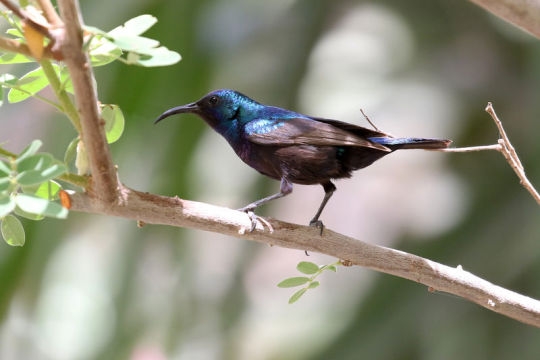
(Image: A male Palestinian sunbird (Cinnyris osea) by Raphaël Jordan)
This little bird is quite resilient-- as are the people of Palestine. You can donate to UNICEF here to support relief work in Gaza.
#palestinian sunbird#Passeriformes#Nectariniidae#double collared sunbirds#sunbirds#perching birds#birds#uncharismatic facts
385 notes
·
View notes
Text
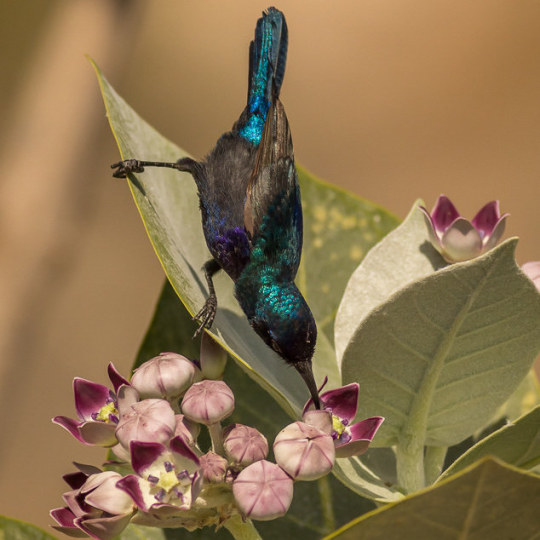
A male Palestine sunbird (Cinnyris osea) feeds from flowers in Oman
by Iordan Hristov
Donate to the Palestine Childrens Relief Fund
Donate to Medical Aid for Palestinians
Donate E-Sims to Gaza
#palestine sunbird#sunbirds#birds#cinnyris osea#cinnyris#nectariniidae#passeriformes#aves#chordata#wildlife: oman#wildlife: asia
502 notes
·
View notes
Text
As usual, females are a lot drabber and lack the iridescent patterns, but they do have the cool curved beak:

Female copper-throated sunbird in southern Thailand. Photo by Ayuwat Jearwattanakanok, 2017.
Sunbirds have a lot in common with hummingbirds: eat lots of nectar, can hover, small, bright iridescent colours, stupid long schnozz. This is convergent evolution and they're not closely related at all.

[2683/11080] Copper-throated sunbird - Leptocoma calcostetha
Order: Passeriformes Suborder: Passeri Superfamily: Passeroidea Family: Nectariniidae (sunbirds and spiderhunters)
Photo credit: Forest Botial-Jarvis via Macaulay Library
#birds#copper-throated sunbird#Leptocoma calcostetha#Leptocoma#sunbird#Nectariniidae#Passeri#passerine#Passeriformes#Australaves#Telluraves#Neoaves#Neognathae#mangroves? what about WOMANgroves
253 notes
·
View notes
Text

Variable Sunbird
110 notes
·
View notes